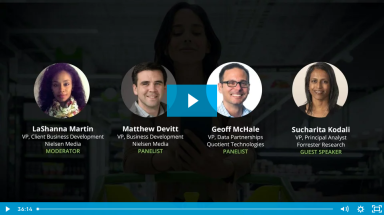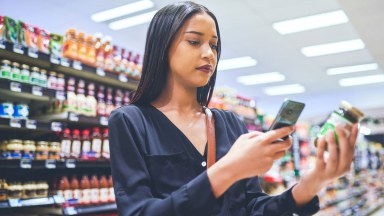It’s been a banner year for global consumer packaged goods (CPG) sales, but not for the right reasons. In addition to forcing consumers around the world to stay home or close to it, the COVID-19 pandemic significantly accelerated the adoption of online CPG shopping, simultaneously heightening consumer expectations for expediency, safety and convenience.
Through this new lens, brands and retailers need to adjust how they engage with consumers—consumers whose expectations, perspectives and realities look much different than they did just 12 months ago. Given the scope of change this year, the adjustments that brands and retailers need to make are just as widespread, spanning everything from communication methods to marketing messaging to varied product assortment—even the best times to communicate with consumers.
In light of the monumental shifts that took place this year, Nielsen recently engaged a group of CPG marketers and advertisers and guest Forrester Research in a virtual panel discussion to illuminate growth paths heading into 2021. Importantly, FMCG sales will remain elevated as consumers spend more time at home, yet brands and retailers will need to transition away from long-established assumptions and practices to ensure they are engaging with consumers across every meaningful touchpoint.
Following the panel, Matt Devitt, VP, Business Development, Nielsen Media, and guest speaker Sucharita Kodali: VP, Principal Analyst, Forrester Research, answered questions around the evolving landscape and key challenges for brands and retailers.
Q: What are the major trends currently disrupting the CPG industry?
Sucharita Kodali: Certainly, the advent of e-commerce marketplaces that sell third-party goods has shaped how shoppers discover, research and buy goods across all categories, including CPG. Shoppers have more information at their fingertips, and there is a proliferation of goods, partly due to more small-batch manufacturing, but also because some marketplace sellers allow goods and promotional pricing to live beyond what a brand may have intended. These are big challenges for CPG manufacturers and the traditional retailers that sell their products.
Q: What are the biggest audience targeting and performance measurement challenges?
Matt Devitt: With the rapid changes in the digital space, marketers are facing the challenge of rethinking how they target, reach and measure the right people. New laws may force more top-of-funnel marketing, which will likely yield some of the best customers in the long term, though it’s not as cheap as engaging existing or down-funnel shoppers. That raises questions about performance measurement. Retailers and brands really need to move away from last-click attribution in digital marketing, which is a rudimentary, albeit easy form of marketing measurement. Attribution, marketing mix models and unified marketing measurement solutions—while may be more costly—are worth the investment.
Q: What are the implications of these challenges for marketers?
MD: Return on investment (ROI) models will be substantially different in the future; they will be more sophisticated, take more touch points into consideration and account for a longer view of customer acquisition and retention. CPG companies will also have tremendously different strategies across different markets depending on their size, industry, etc. Some categories like beauty may benefit a lot from content marketing, but others like frozen food will benefit from more traditional mass advertising. Marketers need to be ruthless in assessing the effectiveness of media channels, their agencies and the metrics their agencies show them. Marketers are discovering inconsistencies in their digital marketing numbers in particular, and eliminating those will be essential.
SK: Every marketer is tasked with inspiring action in some way. Some marketers have short-term goals, while others have long-term goals. Every marketer should have a mix of both. Their goals should be tied to measurement. Digital advertising has, through last-click attribution, created a model that gives marketers a very easy story that suggests success. Traditional advertising hasn’t been able to do the same, so its usage has declined. Meanwhile, Forrester’s data shows that traditional ads are what people are far more likely to pay attention to, so long-term metrics like incremental lift and lifetime value should lead to a balance of online and offline ads over time, which more sophisticated measurement models will support.
Q: What are today’s biggest challenges for CPG advertisers and tomorrow’s top opportunities?
MD: From an epidemic of disloyalty to shrinking shelf space, changing demographics and direct-to-consumer competitors, companies need to work harder to connect with consumers at the right time with the right message.
So, what’s holding CPG brands back from connecting with consumers? Customer intelligence. It’s becoming table stakes in today’s digital economy to have quality first- and third-party data. The upside of using larger, quality datasets is more accurate targeting, which enables stronger marketing performance. Data-confident marketers can fuel a variety of impactful tactics like strategic targeting, email marketing and ROI measurement.
But because of the retailer intermediary, CPG brands often don’t have direct access to the consumer they want to reach or insight into how their advertising affects sales. Advertisers with the least data about their customers are most at risk of wasted spend, and that’s a situation many CPG marketers know all too well. In today’s information-rich environment, making consumers feel less like an anonymous buyer and more like a person with specific wants and needs has become essential.
SK: For tomorrow’s richest opportunities, CPG brands and retailers will need to forge great partnerships. The digital advertising that physical stores themselves will enable in the future could be a big bet. This is the next iteration of temporary price reductions that may sway a shopper in the direction of a particular brand. Imagine if a brand could actually tell its story in the store at the point of sale, and not just on its package. Imagine screens on coolers combined with wired shelves that calculate in-stock levels, and cloud capabilities which transmit all that information simultaneously. That will be an incredible future for CPG advertising.
Click here to enjoy an on-demand replay of the panel discussion.



